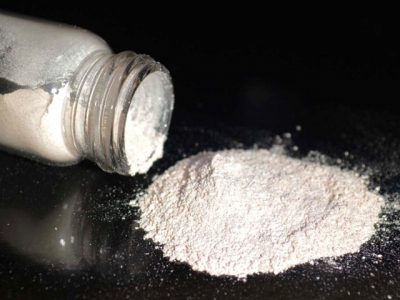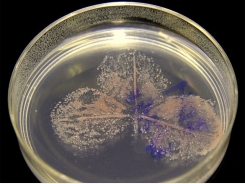A new nutrient for aquaculture, from microbes that consume carbon waste

NovoNutrients readies its ‘microbial consortium’ to produce nutraceutical aquafeed additives
Novomeal is a bulk feed ingredient created by feeding an industrial-waste source of carbon, combined with hydrogen, to a “microbial consortium” in a bioreactor for fermentation. The innovative process is being done by NovoNutrients, based in Silicon Valley, California. Photo courtesy of NovoNutrients.
The pace of innovation in aquaculture feed ingredients is picking up. Entering the fray is a Silicon Valley-born biotechnology firm that, according to its recently appointed CEO, is “coming out of the lab” to commercialize a fishmeal alternative and specialty feed additives that are customizable for numerous seafood species.
NovoNutrients, a company originally formed to produce biofuels, has several advantages as it breaks into aquaculture. First is CEO David Tze – an experienced investor across the entire seafood value chain, from production to feeds to distribution – who joined the company in October.
Secondly, NovoNutrients’ primary input is extremely cheap or even free. In fact, carbon waste producers currently flaring industrial gases could instead pay the company to take the chemicals off their hands.
But most importantly is the proprietary technology, into which interested parties can take a deeper dive when the U.S. Patent and Trademark Office makes the company’s patent application public in the coming months.
Tze told the Advocate recently that NovoNutrients – which won the supply chain track at the investment competition Fish 2.0 in November – is getting “remarkable results” in its R&D lab in Sunnyvale, Calif., from what it calls a “microbial consortium,” a customizable configuration of hydrogen-oxidizing bacteria and other food-grade microbes.

NovoNutrients line of feed additives, Novoceuticals, will include carotenoids, used in feeds to impart a desirable color in salmon fillets, for example. Photo courtesy of NovoNutrients.
“NovoNutrients is a very versatile, low-cost bio-production platform,” said Tze, adding that the company will launch two product lines – Novomeal, a bulk protein ingredient, and Novoceuticals, a line of feed additives like carotenoids, amino acids, fatty acids, vitamins, minerals and antioxidants – within the next five years.
The manufacturing process for a microbial meal is similar to what is used to make tofu, beer, cheese and yogurt. Using a natural fermentation process to capture and convert carbon dioxide and other forms of waste carbon – from raw flue gas, for example – the microbes, which get energy from a hydrogen source, rapidly consume the carbon-hydrogen mixture in a bioreactor to generate specific products: bioplastics, chemicals or a biomass that serves as a nutritious animal feed ingredient.
The question that remains is where will production take place? Oakbio, Inc., dba NovoNutrients, recently modified the lease of its laboratory and office space in Sunnyvale, Calif., and according to Tze is in the beginning phases of its commercialization process. Scaling up is unlikely to happen anywhere near Silicon Valley. Instead, the company will seek proximity to its two key feedstocks for potential production facilities.
“There are a couple of ideal flavors of untreated industrial gas emissions that interest us. One scenario is getting a waste gas, which is primarily carbon dioxide, and separately getting hydrogen. Those are the compounds that we need,” said Tze. “Hydrogen is harder and more expensive to move than carbon dioxide, so in the case that we would have two separate sources of feedstock, we would want to locate close to the hydrogen source.”
Of the industries that produce carbon dioxide, NovoNutrients is looking closely at cement and ethanol.
“Humanity has been struggling to find economic applications to carbon capture and utilization,” said Tze. “It’s the utilization part that’s been difficult and technically challenging.”
Repurposing otherwise-wasted industrial chemicals like methane is a plus for the environment, but the truly exciting work by NovoNutrients happens with the microbial consortium, which Tze refers to as the “workhorses,” or primary producers, in its proprietary system. The consortium, he explained, is a variety of microbes that could not survive directly on carbon dioxide and hydrogen. The microbes are layered in such a way that they take as their inputs the outputs, or the metabolites, of the primary producers.
Scaling is not just a matter of making the same thing bigger.
“We have the capability to include yeast, microalgae and other microbes in the consortium,” he said. “This gives us versatility.”
The Novoceuticals line will be first to market and Tze expects them to be in the hands of potential partners for analysis and trial sometime in 2019. It will take longer to scale up production of the bulk ingredient.
“Manufacturing at commercial scale will in fact happen at two different scales because the inclusion rates of additives and feed nutraceuticals are so much lower than bulk ingredients, like a protein meal,” he added. “The minimum scale of production for nutraceuticals is much, much smaller than that for Novomeal.”
Commercial-scale production for the microbial meal would require what Tze characterized as a “growth factor of about 8,000 times” its current equipment. “That’s not something that happens in two years … scaling is not just a matter of making the same thing bigger. To get from one step to the next, you have to redesign to a certain extent.”
And while many industries are perfecting classic, conventional fermentation, Tze said the ante is higher when the subject of your fermentation is a gas, like carbon dioxide.
“That’s a new technology,” he said. “You can’t just buy an off-the-shelf, 300,000-liter gas fermentation bioreactor, the way you could if you were fermenting liquids.”

Heyward Robinson, VP of corporate development at NovoNutrients, delivered a pitch for the company in front of a panel of expert investors at Fish 2.0 in November. Photo courtesy of Fish 2.0.
A growing number of investors examine aquaculture for opportunities, and Tze sees great potential in fishmeal and fish oil alternatives. The technology developed by NovoNutrients – founded in 2009 by Brian Sefton, who remains chief technology officer – compelled Tze to transition from focusing on his venture capital portfolio at Aquacopia to the operational side. He has invested personally in the business and said that the company has raised about $3 million in funding thus far.
Advancing alternative feeds, he concluded, is one of the few ways to make a “near-universal bet on aquaculture” rather than on a specific species, region or production system.
“It’s one of the very few technologies that [investors] can get behind that can be sold throughout the aquaculture world. We see it as the area where there will be the most rapid adoption [by industry],” said Tze. “Aquaculture is probably the fastest-growing major part of the world food system and it’s an area where there’s tremendous innovation because it was just very recently in its infancy. We’re learning how to do it better and more efficiently – and how to do it with less impact on the environment.”
Có thể bạn quan tâm
Phần mềm

Phối trộn thức ăn chăn nuôi

Pha dung dịch thủy canh

Định mức cho tôm ăn

Phối trộn phân bón NPK

Xác định tỷ lệ tôm sống

Chuyển đổi đơn vị phân bón

Xác định công suất sục khí

Chuyển đổi đơn vị tôm

Tính diện tích nhà kính

Tính thể tích ao hồ



 Shortages of material tra fish continue
Shortages of material tra fish continue  VASEP wants sustainable shrimp farming and export
VASEP wants sustainable shrimp farming and export